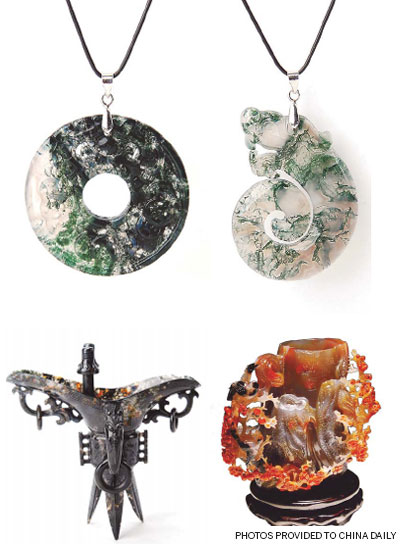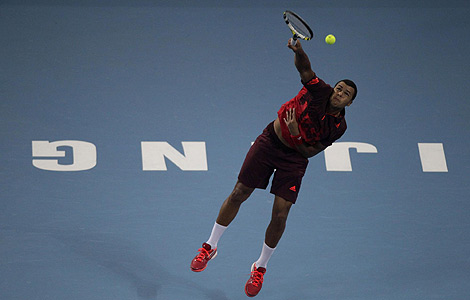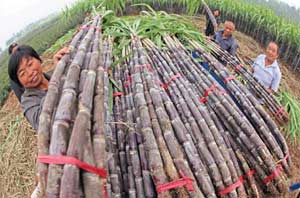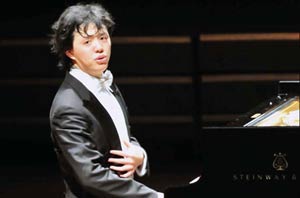Precious rocks
Updated: 2011-10-13 07:50
By Tiffany Tan (China Daily)
|
|||||||||

Liaoning province is known for being a kingdom of jade, agate and amber - and for good reason, Tiffany Tan finds.
It does not take long to realize that Xiuyan county's jade market is no ordinary jade market. Among the endless shelves of jade necklaces, bracelets, key chains and carvings sit these huge, mean-looking and expensive rocks. One, encased in glass, was purchased for 500,000 yuan in 1996 and left there on display. "What is it?" I ask my Chinese travel companion. "Jade," she says. "It's sold uncut? Why would anyone want that?" It soon emerged that, to many Chinese, these dark, rough chunks of stone represent rarity, wealth and beauty. It's been a year since stall owner Zhang Min has sold one of these boulders, a 2-meter tall, 1.5-meter wide piece that can fetch 300,000 yuan ($47,177). For a profit of 60,000 yuan on a single transaction, she says the wait is worthwhile.
"There is a demand," Zhang says. "You just have to wait for the right customer."
Xiuyan county, in southeastern Liaoning province, is China's official "jade capital". It has one of the country's largest jade deposits, which has been exploited since the 1950s.
Besides processing their own jade, local factories and artists also use jade imported from Russia, Canada, Democratic People's Republic of Korea and Myanmar, says the county government.
Its two-story jade market, formally known as China Jade Carving Exhibition Center, is one of the nation's largest jade markets, containing more than 1,000 stalls.
As its name suggests, the market showcases some of China's best jade carvings, in exhibition halls on the first and second floors, including winners of the annual Yuxing and Tiangong jade carving competitions.
Visitors will find an amazing array of designs, such as animals (horses, toads, cranes, dolphins, dragons), plants (peonies, corn, cabbages) and human figures (Buddha, Mao Zedong). A few reflect more contemporary tastes; for example, a military water canteen and a gnome smoking a pipe.
The fusion of craftsmanship and aesthetics on a gemstone is not cheap. A sculpture of wild horses at play costs 12 million yuan ($1.88 million), while a mountain scene etched with 200 Tang Dynasty (AD 618-907) poems is a little less expensive at 8.8 million yuan.
Some 350 km northwest is another locality striving to become a gemstone capital of China: Fuxin city.
Long one of the nation's major coal producers, it is now also churning out jewelry, fashion accessories and home decorations made from agate, a type of quartz.
Agate is less expensive than jade, but its wider variety of colors - white, red, yellow, green, gray, brown, black - allows manufacturers to create a bigger assortment of products.
It's made into Chinese chess sets, belts, cigarette filters, tea sets and pen holders, earrings, pendants and ashtrays.
All these can be found in Fuxin's Xinwei Agate City, which has a couple of hundred shops.
There, you can spend anywhere from 15 yuan for a pair of basic earrings to 1 million yuan for an exquisite animal carving.
Fuxin, which began to develop its agate industry in 1983, now also processes imported agate, mainly from South American countries like Brazil.
While Xiuyan and Fuxin are experiencing a boom in their gemstone industry, Fushun is foreseeing the opposite.
The city in eastern Liaoning began mining amber, a fossil tree resin, 100 years ago. Now its mines are almost depleted, so the prices of local amber products are climbing.
"The price has gone up 90 percent in just the past year," says Zhang Shujing, owner of an amber store located in the Fushun Amber Museum building.
In Zhang's shop is a small amber figurine of a pixiu, a mythical winged lion. The piece, which looks like it was carved out of solidified dark honey, can fit in the palm of your hand. But its price might just break your arm: 3 million yuan.
It's currently the most expensive object in Zhang's store, so she prefers to keep it in a safe, instead of a glass display cabinet.
Like jade and agate, the most popular amber carvings are traditional Chinese designs that embody "good fortune, prosperity, long life and wealth", say industry insiders.
These include the horse, crane, carp, toad and cabbage. But sometimes, sculptors get more unusual requests from foreign customers - such as a basketball or a skeleton head.
Liu Ce contributed to this report.
(China Daily 10/13/2011 page18)









